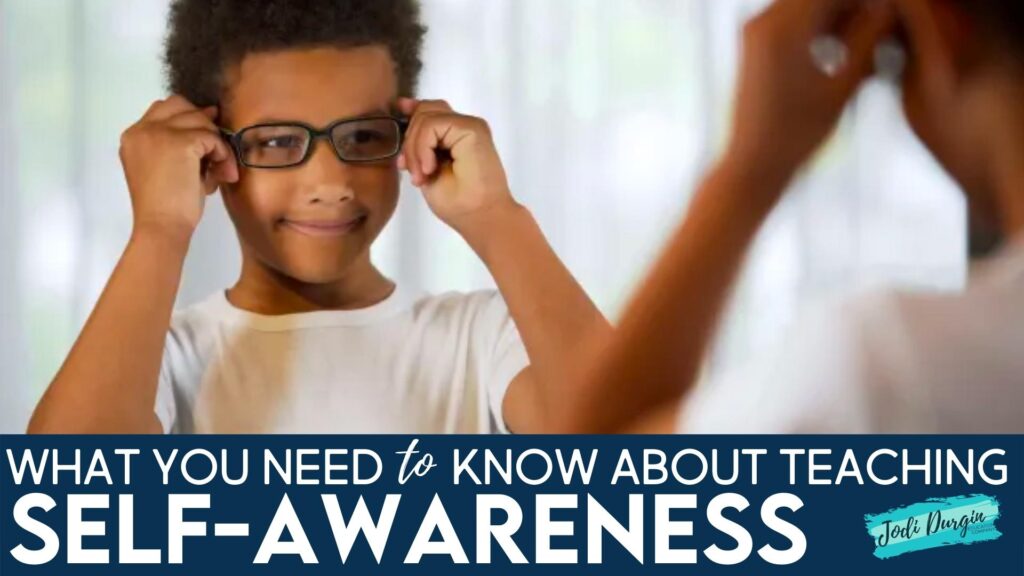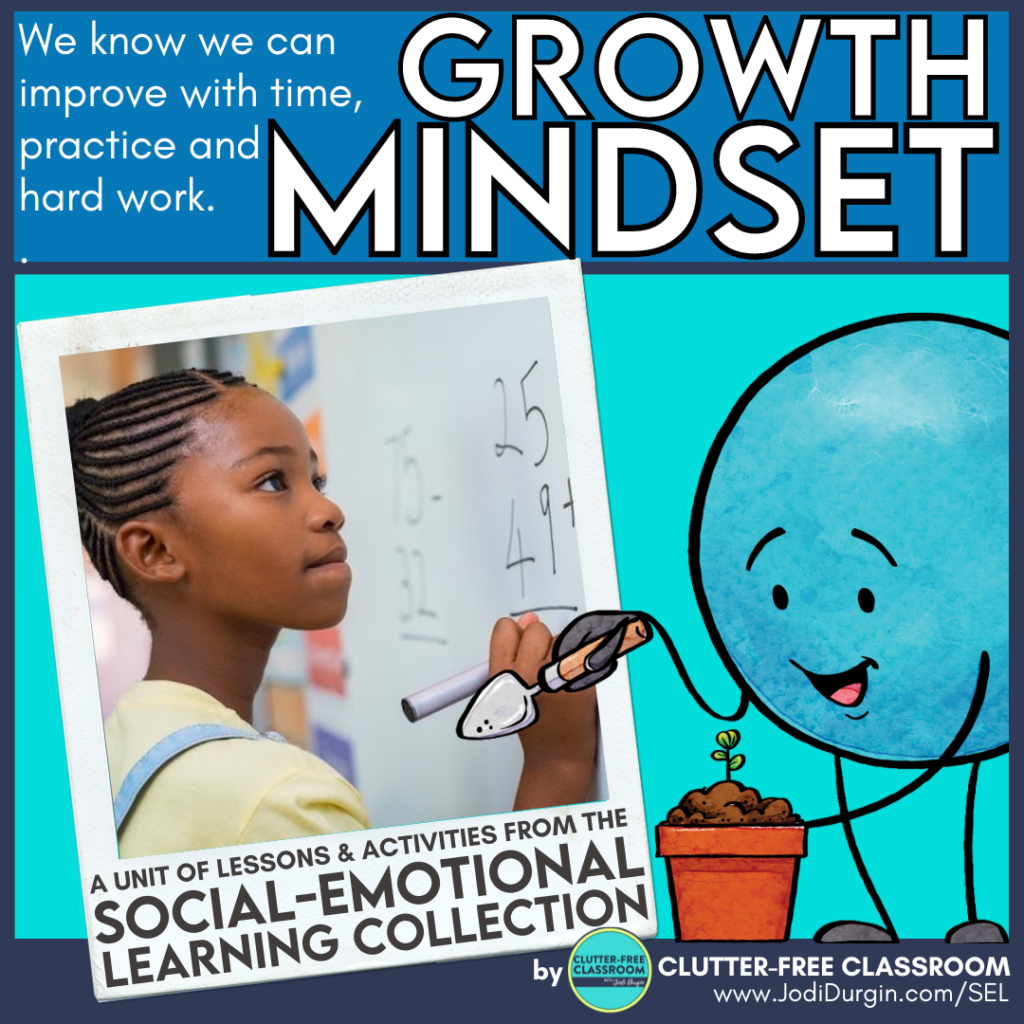If you are an elementary teacher looking for tips and ideas for teaching self awareness in the classroom, then you found the right place! This post includes tons of information about the SEL topic, self awareness.
The Collaborative for Academic, Social, and Emotional Learning (CASEL) created a social emotional learning (SEL) framework. This SEL framework includes five core competencies – one of which is self awareness skills. Teaching self awareness skills is an essential part of social emotional learning curriculum.
This post answers the following questions teachers have about teaching self awareness in the classroom:
- What is self awareness?
- Why is teaching self awareness in the classroom important?
- How can I help my students improve their self awareness skills?
- What are some tips I can share with my students’ families about helping their child improve their self awareness?

What is Self-Awareness?
When your students have self-awareness it means that they have a strong understanding of themself. They understand their thoughts, emotions, strengths and challenges, and their needs. Students having self-awareness is the biggest building block for SEL success. When students use their self-awareness skills, they are also able to understand how their emotions, thoughts, and values influence their behavior. Students who have self-awareness skills also have optimism, self-confidence, and a growth mindset when they are faced with a challenge.
Why is Self-Awareness Important?
Self-awareness is important because students need skills in this area before they can tackle the other SEL competencies. Self-awareness makes students confident learners and plants the seeds of independence that they need in and outside of the classroom and allows them to make better choices. Students who have self-awareness skills know how to ask for help, try different strategies when faced with a problem or when they feel their emotions escalating, and use a growth mindset when challenged.

A Deeper Dive into Self-Awareness
Below is more information to know before teaching self-awareness skills to your students.
Identifying Emotions
Students, especially the younger ones, do not always have the vocabulary to accurately identify their emotions. It is important to provide them with vocabulary for different emotions and teach them what different emotions feel like. When students can identify their emotions, they can think about what causes them to feel that way.
Accurate Self-Perception
When students have self-perception they understand that how they see themselves may be different from how others see them. Students who have skills in this area are able to take a look at themselves and understand their strengths, weaknesses, and accurately perceive their emotions and what causes them to feel certain ways.
Recognizing Strengths
Students recognizing their own strengths and interests is key to their growth as independent motivated individuals. Students can recognize their strengths when they can accurately and honestly state what they are good at. It also allows them to see their weaknesses and know when to ask for help.
Self-Confidence
Students who are self confident believe in themselves and know that they can do challenging things. This fosters independence and starts the process of students being able to solve problems on their own because they believe in their abilities.
Self-Efficacy
Self-efficacy is the belief that you have the ability to perform a task and do difficult things. Kids who have skills in this area know that they have the ability to face challenges. This is where a growth mindset can be fostered in students.

5 Strategies for Helping Kids Improve Self-Awareness
Below are 5 teaching strategies for helping students improve their self awareness skills.
1. Help students identify their strengths and create opportunities to use them
If you have a student who loves technology, create opportunities for them to help others with technology. If you have a student who loves drawing, create opportunities for them to design in the classroom.
2. Model identifying emotions
Name the feelings that you are experiencing and talk about why you are feeling them. Students, especially the younger ones, need this modeling to build the skills in themselves. It also creates awareness that everyone feels emotions and makes you more relatable to your students. Model feeling big and small emotions and talk about the difference between the two.
3. Teach confidence
Confidence does not come easily or naturally to most students. Do activities where they think about what they are good at, what they enjoy doing, and what they like about themselves. One idea is to have students make a compliment list about themselves and keep it with them. Students may need help coming up with compliments about themselves.
4. Teach a growth mindset
Talk about how students have the ability to do hard things and give students challenges to complete, such as STEM challenges. Talk about positive self talk, and the power of “yet.” Check out this growth mindset unit for resources!
5. Try new things as a class
Trying new things will give students opportunities to recognize and use their strengths, grow their confidence, and use a growth mindset. Students will also have practice in identifying and managing the emotions that they feel when doing new things.

5 Tips for Families
Below are 5 tips teachers can share with their students’ families after they introduce and teach self awareness skills in class.
1. Have conversations about your child’s day at school
Talk about different emotions that they had, talk about where they excelled and where they struggled. This will help them practice identifying emotions, build their self-perception, and identify their strengths. Talking about challenges in their day also helps build a growth mindset.
2. Talk about your child’s strengths
Most likely, you know your child’s strengths better than anyone. Help them to identify those strengths and give them opportunities to practice them.
3. Talk about emotions
Have your children see you identifying your emotions and processing why you were feeling them. This will create normalcy around emotions and lends itself to conversations about big emotions and little emotions.
4. Encourage your child to keep a journal
Journals are a great SEL practice that fosters importance of reflection. They can reflect on their day in the journal, record their emotions of the day, reflect on their strengths, or answer specific questions that you ask them.
5. Practice positive self-talk with your child
Use positive talk while talking to the people in your house, when talking about your day, and when talking about challenges in your day. Fostering positive self-talk will help your child believe that they can do hard things and grow their self-confidence and self-efficacy.
We hope you found this post about teaching self awareness skills in the classroom to elementary students helpful! If you did, you may also be interested in these other SEL competency blog posts for teaching relationship skills, self management, responsible decision making, and social awareness.



